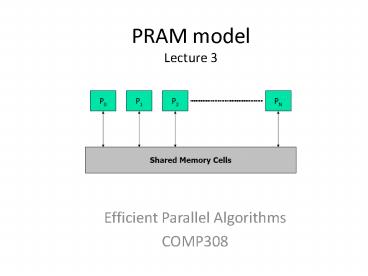PRAM model Lecture 3 - PowerPoint PPT Presentation
Title:
PRAM model Lecture 3
Description:
PRAM model Lecture 3 Efficient Parallel Algorithms COMP308 PRAM PRAM - Parallel Random Access Machine Shared-memory multiprocessor unlimited number of processors ... – PowerPoint PPT presentation
Number of Views:76
Avg rating:3.0/5.0
Title: PRAM model Lecture 3
1
PRAM modelLecture 3
- Efficient Parallel Algorithms
- COMP308
2
PRAM
1
2
- PRAM - Parallel Random Access Machine
- Shared-memory multiprocessor
- unlimited number of processors, each
- has unlimited local memory
- knows its ID
- able to access the shared
- memory in constant time
- unlimited shared memory
P1
3
P2
.
.
.
Pi
.
.
Pn
m
- A very reasonable question Why do we need a PRAM
model? - to make it easy to reason about algorithms
- to achieve complexity bounds
- to analyze the maximum parallelism
3
PRAM MODEL
1
2
P1
3
P2
Common Memory
.
?
.
.
Pi
.
.
Pn
m
PRAM n RAM processors connected to a common
memory of m cells ASSUMPTION at each time unit
each Pi can read a memory cell, make an internal
computation and write another memory
cell. CONSEQUENCE any pair of processor Pi Pj
can communicate in constant time! Pi
writes the message in cell x at time t Pi reads
the message in cell x at time t1
4
Summary of assumptions for PRAM
- PRAM
- Inputs/Outputs are placed in the shared memory
(designated address) - Memory cell stores an arbitrarily large integer
- Each instruction takes unit time
- Instructions are synchronized across the
processors - PRAM Instruction Set
- accumulator architecture
- memory cell R0 accumulates results
- multiply/divide instructions take only constant
operands - prevents generating exponentially large numbers
in polynomial time
5
PRAM Complexity Measures
- for each individual processor
- time number of instructions executed
- space number of memory cells accessed
- PRAM machine
- time time taken by the longest running processor
- hardware maximum number of active processors
6
Two Technical Issues for PRAM
- How processors are activated
- How shared memory is accessed
7
Processor Activation
- P0 places the number of processors (p) in the
designated shared-memory cell - each active Pi, where i lt p, starts executing
- O(1) time to activate
- all processors halt when P0 halts
- Active processors explicitly activate additional
processors via FORK instructions - tree-like activation
- O(log p) time to activate
p
...
1
0
0
0
0
0
0
i processor will activate a processor 2i and a
processor 2i1
8
PRAM
- Too many interconnections gives problems with
synchronization - However it is the best conceptual model for
designing efficient parallel algorithms - due to simplicity and possibility of simulating
efficiently PRAM algorithms on more realistic
parallel architectures
Basic parallel statement for all x in X do in
parallel instruction (x)
For each x PRAM will assign a processor which
will execute instruction(x)
9
Shared-Memory Access
- Concurrent (C) means, many processors can do the
operation simultaneously in the same memory - Exclusive (E) not concurent
- EREW (Exclusive Read Exclusive Write)
- CREW (Concurrent Read Exclusive Write)
- Many processors can read simultaneously the same
location, but only one can attempt to write to a
given location - ERCW (Exclusive Read Concurrent Write)
- CRCW (Concurrent Read Concurrent Write)
- Many processors can write/read at/from the same
memory location
10
Concurrent Write (CW)
- What value gets written finally?
- Priority CW processors have priority based on
which write value is decided - Common CW multiple processors can
simultaneously write only if values are the same - Arbitrary/Random CW any one of the values are
randomly chosen
11
Example CRCW-PRAM
- Initially
- table A contains values 0 and 1
- output contains value 0
- The program computes the Boolean OR of
- A1, A2, A3, A4, A5
12
Example CREW-PRAM
- Assume initially table A contains 0,0,0,0,0,1
and we have the parallel program
13
Pascal triangle
PRAM CREW
14
Parallel Addition
- log(n) stepstime needed
- n/2 processors needed
- Speed-up n/log(n)
- Efficiency 1/log(n)
- Applicable for other
- operations too
- , , lt, gt, etc.
15
Membership problem
- p processors PRAM with n numbers (p n)
- Does x exist within the n numbers?
- P0 contains x and finally P0 has to know
- Algorithm
- step1 Inform everyone what x is
- step2 Every processor checks n/p numbers and
sets a flag - step3 Check if any of the flags are set to 1
16
THE PRAM IS A THEORETICAL (UNFEASIBLE) MODEL
- The interconnection network between processors
and memory would require - a very large amount of area .
- The message-routing on the interconnection
network would require time - proportional to network size (i. e. the
assumption of a constant access time - to the memory is not realistic).
WHY THE PRAM IS A REFERENCE MODEL?
- Algorithms designers can forget the
communication problems and focus their - attention on the parallel computation only.
- There exist algorithms simulating any PRAM
algorithm on bounded degree - networks.
- Statement 1. A PRAM algorithm requiring time
T(n), can be simulated in a mesh of tree in time
T(n)log2n/loglogn, that is each step can be
simulated with a slow-do of log2n/loglogn. - Statement 2. Any problem that can be solved for a
p processor PRAM in t steps can be solved ina p
processor PRAM in tO(tp/p) steps - Instead of design ad hoc algorithms for bounded
degree networks, design more - general algorithms for the PRAM model and
simulate them on a feasible network.

